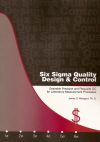Advanced Quality Management / Six Sigma
A Six Sigma Design Tool
The OPSpecs chart (operating specifications) is an ideal Six Sigma tool. It allows us to easily identify how our laboratory processes are performing -- and gives us immediate guidance on where dramatic improvements can be made and what impact those improvements will have. Whether your're trying to establish performance specifications for imprecision and inaccuracy for a method, or just trying to pick the right control rule for a test, the OPSpecs chart is your best pick. (Preview)
- Graphical display of process performance
- Attributes related to process capability
- Graphical assessement of process performance
- Performance characteristics of statistical QC
- Graphical display of QC performance
- Attributes related to QC capability or performance
- Summary of the attributes of an OPSpecs Chart
- References
The OPSpecs chart is an ideal Six Sigma assessment and design tool for laboratory testing processes, whether your interest is to establish method performance specifications for imprecision and inaccuracy or to establish appropriate statistical control rules and numbers of control measurements. The next lessons provide a more detailed description of the OPSpecs Chart and a justification for its use as a Six Sigma planning tool.
Some readers may want to skip this material, trusting that the documentation in the peer-reviewed scientific literature provides a sufficient validation of the tool [1-4]. Others may want to see practical applications rather than a theoretical justification. Again, there are peer-reviewed papers that describe how OPSpecs charts can be used to select QC procedures for immunoassays [5], blood gas measurements [6], and lipid tests [7]; evaluate the "state of the art" precision performance [8]; assess the imprecision required by clinical and analytical test outcome criteria [9]; compare the precision required by European biologic goals and US CLIA total error criteria [10]; and even design patient data techniques, such as Average of Normals (AoN) algorithm, for use to measure the length of the analytical run [11]. There are also more detailed applications available in the QC Applications category.
For those who want the whole story on how and why OPSpecs charts work, read on! I'll first demonstrate the graphical characteristics or attributes of the OPSpecs chart and how this tool can characterize process performance and also represent the error detection capabilities of different QC procedures. The next lessons will provide new details and explanations:
- an "error budget" framework to identify the factors that need to be considered when working with analytical and clinical quality requirements.
- a more mathematical explanation in the form of quantitative quality-planning models that show the relationships between method performance characteristics, QC performance characteristics, and analytical and clinical quality requirements.
- how OPSpecs charts can be prepared using computer programs.
Feel free to pursue this discussion of "tools and technology" as far as you want. Also feel free to skip to the applications when you need a break from this material, understand the mechanics of using this tool, and are satisfied the OPSpecs chart is a valid design tool for applications in Six Sigma Quality Management.
 Want to read more of this article?
Want to read more of this article?
We invite you to purchase the Six Sigma QC Design and Control manual, Second Edition, available at our online store. You can also download the Table of Contents and a Sample chapter.
